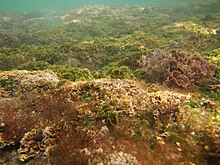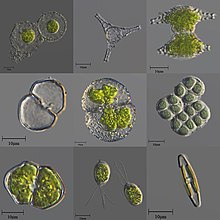Portal:Algae
Introduction
Algae (UK: /ˈælɡiː/ AL-ghee, US: /ˈældʒiː/ AL-jee; sg.: alga /ˈælɡə/ AL-gə) are any of a large and diverse group of photosynthetic, eukaryotic organisms. The name is an informal term for a polyphyletic grouping that includes species from multiple distinct clades. Included organisms range from unicellular microalgae, such as Chlorella, Prototheca and the diatoms, to multicellular forms, such as the giant kelp, a large brown alga which may grow up to 50 metres (160 ft) in length. Most are aquatic and lack many of the distinct cell and tissue types, such as stomata, xylem and phloem that are found in land plants. The largest and most complex marine algae are called seaweeds, while the most complex freshwater forms are the Charophyta, a division of green algae which includes, for example, Spirogyra and stoneworts. Algae that are carried by water are plankton, specifically phytoplankton.
Algae constitute a polyphyletic group since they do not include a common ancestor, and although their plastids seem to have a single origin, from cyanobacteria, they were acquired in different ways. Green algae are examples of algae that have primary chloroplasts derived from endosymbiotic cyanobacteria. Diatoms and brown algae are examples of algae with secondary chloroplasts derived from an endosymbiotic red alga. Algae exhibit a wide range of reproductive strategies, from simple asexual cell division to complex forms of sexual reproduction.
Algae lack the various structures that characterize land plants, such as the phyllids (leaf-like structures) of bryophytes, rhizoids of non-vascular plants, and the roots, leaves, and other organs found in tracheophytes (vascular plants). Most are phototrophic, although some are mixotrophic, deriving energy both from photosynthesis and uptake of organic carbon either by osmotrophy, myzotrophy, or phagotrophy. Some unicellular species of green algae, many golden algae, euglenids, dinoflagellates, and other algae have become heterotrophs (also called colorless or apochlorotic algae), sometimes parasitic, relying entirely on external energy sources and have limited or no photosynthetic apparatus. Some other heterotrophic organisms, such as the apicomplexans, are also derived from cells whose ancestors possessed plastids, but are not traditionally considered as algae. Algae have photosynthetic machinery ultimately derived from cyanobacteria that produce oxygen as a by-product of photosynthesis, unlike other photosynthetic bacteria such as purple and green sulfur bacteria. Fossilized filamentous algae from the Vindhya basin have been dated back to 1.6 to 1.7 billion years ago. (Full article...)
Selected general article
GEOHAB is an international research programme on the Global Ecology and Oceanography of Harmful algal blooms.
It was initiated in 1998 by the Scientific Committee on Oceanic Research (of ICSU) and the Intergovernmental Oceanographic Commission of UNESCO. (Full article...)
Selected algae type
The green algae (sg.: green alga) are a group of chlorophyll-containing autotrophic eukaryotes consisting of the phylum Prasinodermophyta and its unnamed sister group that contains the Chlorophyta and Charophyta/Streptophyta. The land plants (Embryophytes) have emerged deep in the Charophyte alga as a sister of the Zygnematophyceae. Since the realization that the Embryophytes emerged within the green algae, some authors are starting to include them.[excessive citations] The completed clade that includes both green algae and embryophytes is monophyletic and is referred to as the clade Viridiplantae and as the kingdom Plantae. The green algae include unicellular and colonial flagellates, most with two flagella per cell, as well as various colonial, coccoid and filamentous forms, and macroscopic, multicellular seaweeds. There are about 22,000 species of green algae, many of which live most of their lives as single cells, while other species form coenobia (colonies), long filaments, or highly differentiated macroscopic seaweeds.
A few other organisms rely on green algae to conduct photosynthesis for them. The chloroplasts in dinoflagellates of the genus Lepidodinium, euglenids and chlorarachniophytes were acquired from ingested endosymbiont green algae, and in the latter retain a nucleomorph (vestigial nucleus). Green algae are also found symbiotically in the ciliate Paramecium, and in Hydra viridissima and in flatworms. Some species of green algae, particularly of genera Trebouxia of the class Trebouxiophyceae and Trentepohlia (class Ulvophyceae), can be found in symbiotic associations with fungi to form lichens. In general the fungal species that partner in lichens cannot live on their own, while the algal species is often found living in nature without the fungus. Trentepohlia is a filamentous green alga that can live independently on humid soil, rocks or tree bark or form the photosymbiont in lichens of the family Graphidaceae. Also the macroalga Prasiola calophylla (Trebouxiophyceae) is terrestrial, and Prasiola crispa, which live in the supralittoral zone, is terrestrial and can in the Antarctic form large carpets on humid soil, especially near bird colonies. (Full article...)
Selected images
Get involved
WikiProject Algae is dedicated to focusing the efforts of Wikipedia contributors on algae-related articles. Find articles to work on on its taxon notes page.
Subategories
Associated Wikimedia
The following Wikimedia Foundation sister projects provide more on this subject:
-
Commons
Free media repository -
Wikibooks
Free textbooks and manuals -
Wikidata
Free knowledge base -
Wikinews
Free-content news -
Wikiquote
Collection of quotations -
Wikisource
Free-content library -
Wikispecies
Directory of species -
Wikiversity
Free learning tools -
Wiktionary
Dictionary and thesaurus



















